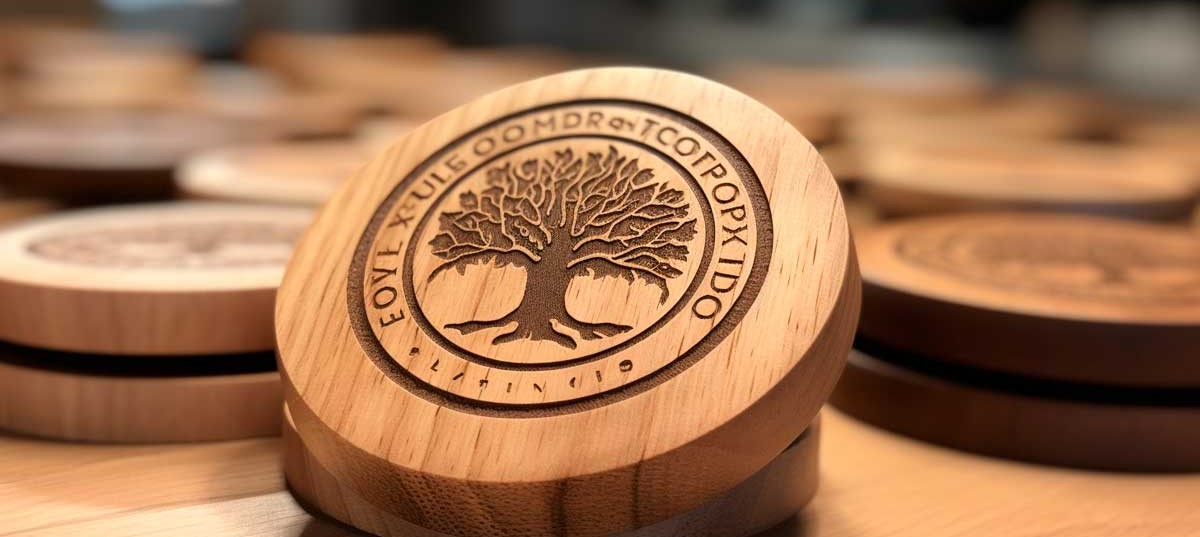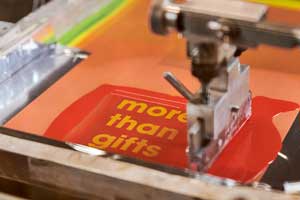What is sublimation?
Discover this revolutionary printing process that turns any colorful digital design into high-quality personalized gifts, thanks to the power of sublimation heat press.
Sublimation printing is a technique that allows fixing a design on different gift items and garments, giving the possibility to customize on different materials to achieve lasting and professional results.
What sets it apart is that it allows customizing colorful prints with optimal quality. It is a versatile type of marking because it can be applied to fabrics, promotional ceramic products such as mugs, or metal items.
Quelle est l'origine de la sérigraphie ?
L'origine de la sérigraphie remonte à la Chine ancienne, il y a environ 2000 ans. À l'époque, la technique était utilisée pour filtrer l'encre et créer des motifs sur la soie, d'où le nom "sérigraphie", qui provient des mots latins "sericum" (soie) et "graphium" (écrire ou dessiner).
Au fil du temps, cette technique s'est répandue dans d'autres cultures et régions, et les méthodes et les matériaux utilisés ont été affinés. Au XVIIIe siècle, elle est arrivée en Europe, où elle était principalement utilisée pour la décoration de textiles et l'impression de papiers peints.
Ce n'est qu'au XXe siècle que la sérigraphie est devenue une technique d'impression commercialement viable et populaire. Au cours de cette période, de nouvelles technologies et de nouveaux matériaux ont été développés, permettant une plus grande précision et une meilleure qualité des designs imprimés.
Aujourd'hui, la sérigraphie reste largement utilisée dans l'industrie de l'impression et de la personnalisation, tant sur le plan commercial qu'artistique. Sa capacité à imprimer sur une grande variété de matériaux et sa polyvalence dans la reproduction de designs colorés en font un choix privilégié pour l'impression publicitaire et la personnalisation.
Types of Sublimation
Heat sublimation is a process in which a solid turns into vapor without going through the intermediate liquid state. There are two types: direct sublimation, which is the sublimation process that occurs directly on the solid material, and transfer sublimation, where a transfer material is used to transfer the image or design to another object. Below, we develop the main characteristics of each one, to help you to choose the best sublimation.
Direct Sublimation
Direct sublimation is a process in which the solid material turns into vapor without going through the intermediate liquid state. It is used to transfer an image or design to an object using heat and pressure. For this, a special printer is used that uses special inks that evaporate when heat and pressure are applied.
This process can be applied to a wide variety of materials, such as fabrics, ceramics, glass, metals, and plastics. Furthermore, direct sublimation offers high-quality printing with vibrant and durable colors that do not fade or peel over time, as long as they are properly cared for.
Transfer Sublimation
Transfer sublimation is a process in which a transfer material is used to transfer an image or design to another object. For this, the image is printed on special sublimation paper with special inks. Then, the paper is placed in contact with the object to be sublimated, and heat and pressure are applied to transfer the image.
This process can be applied to a wide variety of materials, such as fabrics, ceramics, glass, metals, and plastics. Furthermore, transfer sublimation offers high-quality printing with vibrant and durable colors that do not fade or peel over time, as long as they are properly cared for.
Sublimation transfer is a good option for customizing unique objects or those that cannot be directly sublimated due to their shape or size.
What Does Sublimation Involve?
This technique is named after the physical process with the same name, which involves the transition from the solid to the gaseous state without going through the liquid state.
This method allows for the customization of promotional merchandise by transferring ink to a surface through the application of heat. The sublimation process involves transferring the selected design to special paper. Then, this paper is placed on the item, and pressure is applied with a heat press to transfer the ink from the paper to the object and fix it. Heat is what causes the sublimation process.
It is important to note that this technique can only be done on polyester fabrics. If you are looking for full-color cotton shirts, other methods such as digital transfer or DTG printing should be used. For corporate gifts with rigid surfaces, like a mug, they must have a polyester coating.
In fabrics, the ink becomes part of the fabric itself, allowing the design to have a smooth and imperceptible touch, and in the case of promotional products such as water bottles, the printing is transferred beneath the coated surface.
What Are the Advantages of Sublimation? And Disadvantages?
This technique offers multiple advantages that make it one of the most common and popular options.
Durability
One aspect that distinguishes sublimation is the durability of the designs, which is greater than with other printing methods, such as screen printing. In the case of garments, this is because the ink chemically fuses with the fabric, ensuring that the customized garment lasts over time without deteriorating or fading through washes.
In the case of more rigid items, such as mugs, it offers resilient designs that do not deteriorate with daily use, being suitable for microwave and dishwasher use.
Inks
Sublimation is imperceptible to the touch, and there is no limit to the number of colors, allowing for the printing of designs with all kinds of shades and gradients.
It also allows for large marking areas, covering up to 100% of the surface. The CMYK color model is used in the design.
As for its disadvantages:
Product color
This process is only done on white objects. On other colors, the result is not as satisfactory, which is why it is recommended to avoid it.
Product material
Furthermore, as mentioned earlier, it can only be applied to polyester garments or rigid surfaces with a special coating of this material. Its cost is usually higher than other marking techniques, such as screen printing.
Best Products for Personalization through Sublimation
The first thing to consider when thinking about using sublimation is the material and color of the product, as mentioned earlier.
It allows for a wide range of personalized gifts, with two of the most common being:

Sublimated T-shirts
Their strength undoubtedly lies in technical shirts and sportswear, as they do not cover the fabric's pores, allowing for breathability and preventing clothing from becoming soaked with sweat. Furthermore, this type of printing is imperceptible to the touch.

Sublimated Mugs
This process can be used on concave surfaces, making it an excellent option for personalized mugs if you want to customize them with full-color photos or designs.
What Is the Difference Between Sublimation and Screen Printing?
Both techniques are very common in the field of promotional gifts, as both offer very good results, but they have significant differences in both the process and the finish. Let's get into the details!
Sublimation
Full-color personalization: Sublimation allows for full-color designs on a white background, making it the best choice if you want customization with many tones and colorful details.
Durability and resistance: During the sublimation process, the ink blends with the polyester fabric's fibers, ensuring that the design does not fade or peel over time, washes, or wear.
Material and color limitations: Sublimation is only compatible with white polyester garments and objects with a polyethylene coating. It cannot be applied to fabrics of other materials or garments of colors other than white.
Screen Printing
Material versatility: Screen printing can be applied to a wide range of materials, such as textiles, plastics, glass, metal, and wood. It is suitable for printing on different surfaces and textures.
Multi-ink printing capability: Screen printing allows for designs with 1 to 4 inks, providing a good level of detail and the ability to use different colors in a design. However, it does not allow full-color prints like sublimation.
Economical cost: Single-color screen printing is usually more economical than sublimation, especially in large print runs. However, adding more inks to screen printing increases fixed costs.
In summary, sublimation excels in its ability to provide full-color personalization and durability on polyester clothing, while screen printing is versatile in different materials and economically more viable for solid color prints with few details.
The choice of technique will depend on the specific requirements of the project, budget, and desired finish.
Transfer and Sublimation. Differences between These Types of Printing
Sublimation and transfer are two widely used personalization techniques in the world of promotional gifts. Although both are used for printing, they have some important differences that are important to know, which we explain below. Sublimation:
Sublimation
Compatible materials: Sublimation is primarily applied to white polyester clothing or rigid objects with a special polyethylene coating. It is not compatible with fabrics of other materials or clothing of colors other than white.
Durability and resistance: Sublimated designs are durable and resistant. Due to the ink transfer process using heat, the design fuses with the polyester fibers, resulting in greater resistance to washing and wear.
Full-color: Sublimation is based on ink blending to create the design, which means there is no limit to the colors, although they may vary depending on the process and materials used. When printing on white clothing, the result is usually more faithful to the original design.
Transfer
Fabric versatility: Transfer can be applied to a wide variety of fabrics, including clothing of different colors. However, it is important to consider that it is not suitable for all materials and surfaces, as it generally adheres better to fabrics.
Application process: Transfer uses a vinyl sticker printed with the design, which is then transferred to the desired surface using heat and pressure. It is a simpler process compared to sublimation, as it does not involve ink blending.
Limited durability and resistance: Although transfer can produce visually appealing results, the designs tend to have less durability and resistance compared to sublimation. The sticker's adhesion can wear off over time and with frequent washing, which can affect the design's appearance.
In summary, sublimation is better suited for white polyester clothing and objects with a special coating, as it offers greater durability and resistance but has color limitations.
Transfer is more versatile in terms of fabrics and colors but has less durability and resistance and adheres better to fabrics than other surfaces.
What Is the Cost of Personalization with Sublimation?
Sublimated products may have a slightly higher cost than others, but if you are looking for full-color finishes, the difference decreases because compared to other types of customization, the cost is the same regardless of the number of colors in the design.
However, do not let the price become a drawback; remember its advantages as well. On one hand, its durability - sublimation provides resilient designs capable of withstanding daily use without the design deteriorating. On the other hand, it allows for full-color personalizations, something not all marking methods offer.
Conclusions
As you already know, sublimation is a process that uses heat and pressure to transfer an image or design to an object, and there are two types, direct and transfer. Both techniques allow for high-quality printing on a variety of materials and offer the possibility of personalizing objects quickly and efficiently.
Finally, remember that although the initial investment may be high, production costs are relatively low in the long run compared to other custom printing techniques. Sublimation is an effective and durable technique for personalizing products.


